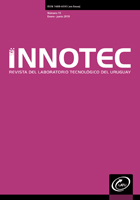Nanocomplexes formation between polyphenols of apple peels and beta-lactoglobulin for their potential application in functional foods
DOI:
https://doi.org/10.26461/15.02Keywords:
polyphenols, apple peel, beta-lactoglobulin, nanocomplexesAbstract
Polyphenols (PF) exert an important influence on human health, mainly due to their antioxidant capacity. Apples have PF mainly in their peel. Te major whey protein, beta-lactoglobulin (β-lg), can bind amphiphilic compounds, such as PF, protecting them from the action of external agents. In this work, nanocomplexes (NC) of PF extracted from red apple peel (Red Delicious), and β-lg were studied. By ultrafltration it was determined that 57% of the PF added bound to the protein. Fluorescence extinction of β-lg by PF addition performed at different temperatures confrmed the formation of a static complex. Te fluorescence extinction of β-lg with acrylamide did not vary signifcantly in the presence of PF, indicating that PF bound to a site different from the hydrophobic pocket of the protein. Particle size and ζ potential measurements of β-lg were not signifcantly modifed by the addition of PF. Tis fact pointed to a low number of PF bounded to the dimer of the protein. In conclusion, NC would allow PF vehiculization, their protection and use for enrichment functional foods.
Downloads
References
this is possible or desirable. En: International Journal of Food Sciences and Nutrition, 63(1), pp.62–70.
CAFI- Cámara Argentina de Fruticultores Integrados, 2017. Mercado mundial de la manzana [En línea]. Río Negro: CAFI. [Consulta: 10-02-2018]. Disponible en: http://www.caf.org.ar/mercado-mundial-de-la-manzana/
Charlton, A.J., Baxter, N.J., Lokman Khan, M., Moir, A.J.G., Haslam, E., Davies, A.P., et al., 2002. Polyphenol/peptide
binding and precipitation. En: Journal of Agricultural and Food Chemistry, 50, pp.1593-1601.
Chen, L. y Subirade, M., 2006. Alginate–whey protein granular microspheres as oral delivery vehicles for bioactive
compounds. En: Biomaterials, 27(26), pp.4646-4654.
Del Río, D, Rodriguez-Mateos, A, Spencer, JPE, Tognolini, M, Borges, G. y Crozier, A, 2013. Dietary (poly) phenolics in human health: structures, bioavailability, and evidence of protective effects against chronic diseases. En: Antioxidants y Redox Signaling, 18(14), pp.1818–1892.
Delorenzi, N. J., 2005. Beta-lactoglobulin conformational changes studied by fluorescence quenching. En: Riley,
Arthur P., ed., 2005. Food research, safety and policies. Cap.7. New York: Nova Science Publishers. pp.159–174.
Escarpa, A. y González, M.C., 1998. High-performance liquid chromatography with diode-array detection for the determination of phenolic compounds in peel and pulp from different apple varieties. En: Journal of
Chromatography, 823, pp.331-337.
Jacobo-Velázquez, D.A. y Cisneros-Zevallos, L., 2012. An alternative use of horticultural crops: stressed plants
as biofactories of bioactive phenolic compounds. En: Agriculture, 2(3), pp.259-271.
Jakobek, L. y Barron, A.R., 2016. Ancient apple varieties from Croatia as a source of bioactive polyphenolic compounds. En: Journal of Food Composition and Analysis, 45, pp.9-15.
Kanakis, C.D., Hasni, I., Bourassa, P., Tarantilis, P.A., Polissiou, M.G. y Tajmir-Riahi, H.A., 2011. Milk β-lactoglobulin complexes with tea polyphenols. En: Food Chemistry, 127(3), pp.1046-1055.
Kontopidis, G., Holt, C. y Sawyer, L., 2004. Beta-lactoglobulin: binding properties, structure, and function. En: Journal of Dairy Science, 87, pp.785-796.
Lakowicz, J.R., 2006. Quenching of fluorescence. En: Lakowicz, Joseph R. Principles of fluorescence spectroscopy.
3rd ed. Cap.8. New York: Springer. pp.323-350.
Landete, J.M., 2012. Updated knowledge about polyphenols: functions, bioavailability, metabolism, and health. En: Critical Reviews in Food Science and Nutrition, 52(26), pp.936–948.
Liang, L. y Subirade, M., 2012. Study of the acid and thermal stability of blactoglobulin–ligand complexes using
fluorescence quenching. En: Food Chemistry, 132(4), pp.2023–2029.
Lima, G.P.P., Vianello, F., Corrêa, C.R., da Silva Campos, R.A. y Borguini, M.G., 2014. Polyphenols in Fruits and
Vegetables and Its Effect on Human Health. En: Food and Nutrition Sciences, 5(11), pp.1065.
Livney, Y.D., 2010. Milk proteins as vehicles for bioactives. En: Current Opinion in Colloid & Interface Science, 15,
pp.73-83.
Livney, Y.D., 2017. Nanoencapsulation technologies. En: Roos, Yrjö H. y Livney, Yoav D., eds. Engineering foods
for bioactives stability and delivery. New York: Springer. pp.143-169.
Moro, A., Gatti, C.A. y Delorenzi, N.J., 2001. Hydrophobicity of whey protein concentrates measured by fluorescence quenching and its correlation with surface functional properties. En: Journal of Agricultural and Food Chemistry, 49, pp.4784-4789.
Nagy, K., Courtet-Compondu, M.C., Williamson, G., Rezzi, S., Kussmann, M. y Rytz, A., 2012. Non-covalent binding of proteins to polyphenols correlates with their amino acid sequence. En: Food Chemistry, 132, pp.1333-1339.
Poncet-Legrand, C., Edelmann, A., Putaux, J.L., Cartalade, D., Sarni-Manchado, P. y Vernhet, A., 2006. Poly (L-proline) interactions with flavan-3-ols units: Influence of the molecular structure and the polyphenol/protein ratio. En: Food Hydrocolloids, 20(5), pp.687-697.
Quintanilla-Carvajal, M.X., Camacho-Díaz, B.H., MerazTorres, L.S., Chanona-Pérez, J.J., Alamilla-Beltrán, L.,
Jiménez Aparicio, A. y Gutiérrez-López, G.F., 2010. Nanoencapsulation: a new trend in food engineering
processing. En: Food Engineering Reviews, 2(1), pp.39-50.
Reyes, L.F. y Cisneros-Zevallos, L., 2003. Wounding stress increases the phenolic content and antioxidant capacity of purple-flesh potatoes (Solanum tuberosum L.). En: Journal of Agricultural and Food Chemistry, 51(18), pp.5296-5300.
Rodríguez, S.D., Von Staszewski, M. y Pilosof, A.M., 2015. Green tea polyphenols-whey proteins nanoparticles:
Bulk, interfacial and foaming behavior. En: Food Hydrocolloids, 50, pp.108-115.
Sekhon, B.S., 2010. Food nanotechnology e an overview. En: Nanotechnology, Science and Applications, (3), pp.1-15.
Singleton, V.L., Orthofer, R. y Lamuela-Raventos, R.M., 1999. Analysis of total phenols and other oxidation substrates and antioxidants by means of the Folin–Ciocalteu reagent. En: Methods in Enzymology, 299, pp.152–178.
Solovchenko, A. y Schmitz-Eiberger, M., 2003. Signifcance of skin flavonoids for UV-B-protection in apple fruits. En: Journal of Experimental Botany, 54, pp.1977-1984.
Tavares, G.M., Croguennec, T., Carvalho, A.F., Bouhallab, S., 2014. Milk proteins as encapsulation devices and delivery vehicles: Applications and trends. En: Trends in Food Science & Technology, 37, pp.5-20.
Valavanidis, A., Vlachogianni, T., Psomas, A., Zovoili, A. y Siatis, V., 2009. Polyphenolic profle and antioxidant
activity of fve apple cultivars grown under organic and conventional agricultural practices. En: International
Journal of Food Science & Technology, 44(6), pp.1167-1175.
Vieira, F.G.K., Borges, G.D.S.C., Copetti, C., Di Pietro, P.F., da Costa, Nunes, E. y Fett, R., 2011. Phenolic compounds
and antioxidant activity of the apple flesh and peel of eleven cultivars grown in Brazil. En: Scientia Horticulturae,
128(3), pp.261-266.
Von Staszewski, M., Jara, F.L., Ruiz, A.L., Jagus, R.J., Carvalho, J.E. y Pilosof, A.M., 2012. Nanocomplex formation
between β-lactoglobulin or caseinomacropeptide and green tea polyphenols: Impact on protein gelation and
polyphenols antiproliferative activity. En: Journal of Functional Foods, 4(4), pp.800-809.
Von Staszewski, M., Ruiz-Henestrosa, V.M.P. y Pilosof, A.M., 2014. Green tea polyphenols-β-lactoglobulin
nanocomplexes: Interfacial behavior, emulsifcation and oxidation stability of fsh oil. En: Food Hydrocolloids, 35,
pp.505-511.
Wang, X., Li, C., Liang, D., Zou, Y., Li, P. y Ma, F., 2015. Phenolic compounds and antioxidant activity in redfleshed apples. En: Journal of Functional Foods, 18, pp.1086-1094.
Wolfe, K., Wu, X. y Liu, R.H., 2003. Antioxidant activity of apple peels. En: Journal of Agricultural and Food
Chemistry, 51(3), pp.609-614.
Downloads
Published
How to Cite
Issue
Section
License
Los autores del manuscrito declaran conocer y aceptar los siguientes términos de responsabilidad:
Haber participado lo suficiente en el trabajo como para hacer pública la responsabilidad por su contenido.
Que el manuscrito representa un trabajo original que no fue publicado ni está siendo considerado por otra revista para su publicación, en parte o en forma íntegra, tanto impresa como electrónica.
Que en caso de ser solicitado, procurará o cooperará en la obtención y suministro de datos sobre los cuales el manuscrito esté basado.
Declara que la información divulgada que pudiera pertenecer a un tercero cuenta con la autorización correspondiente.
Autorización para la publicación y compromiso de cita de primera publicación
Los autores/as conservan los derechos de autor y ceden a la revista INNOTEC / INNOTEC Gestión el derecho de la primera publicación, con el trabajo registrado con la licencia de atribución Creative Commons Reconocimiento-NoComercial 4.0 Internacional. Creative Commons, que permite a terceros utilizar lo publicado siempre que mencionen la autoría del trabajo y a la primera publicación en esta revista sin fines comerciales.
El autor se compromete a realizar la cita completa de la edición institucional de esta primer publicación en las siguientes publicaciones -completas o parciales- efectuadas en cualquier otro medio de divulgación, impreso o electrónico.
Los autores/as pueden realizar otros acuerdos contractuales no comerciales independientes y adicionales para la distribución no exclusiva de la versión del artículo publicado en esta revista (p. ej., incluirlo en un repositorio institucional o publicarlo en un libro) siempre que indiquen claramente que el trabajo se publicó por primera vez en esta revista.
Se permite a los autores/as publicar su trabajo en Internet (por ejemplo en páginas institucionales o personales) antes y durante el proceso de revisión, ya que puede conducir a intercambios productivos y a una mayor y más rápida difusión del trabajo publicado (vea The Effect of Open Access). A su vez los autores/as autorizan al LATU a publicar el trabajo en su repositorio digital.
Los conceptos y opiniones vertidos en los artículos son de responsabilidad de sus autores.
Este obra está bajo una licencia Reconocimiento-NoComercial 4.0 Internacional.












